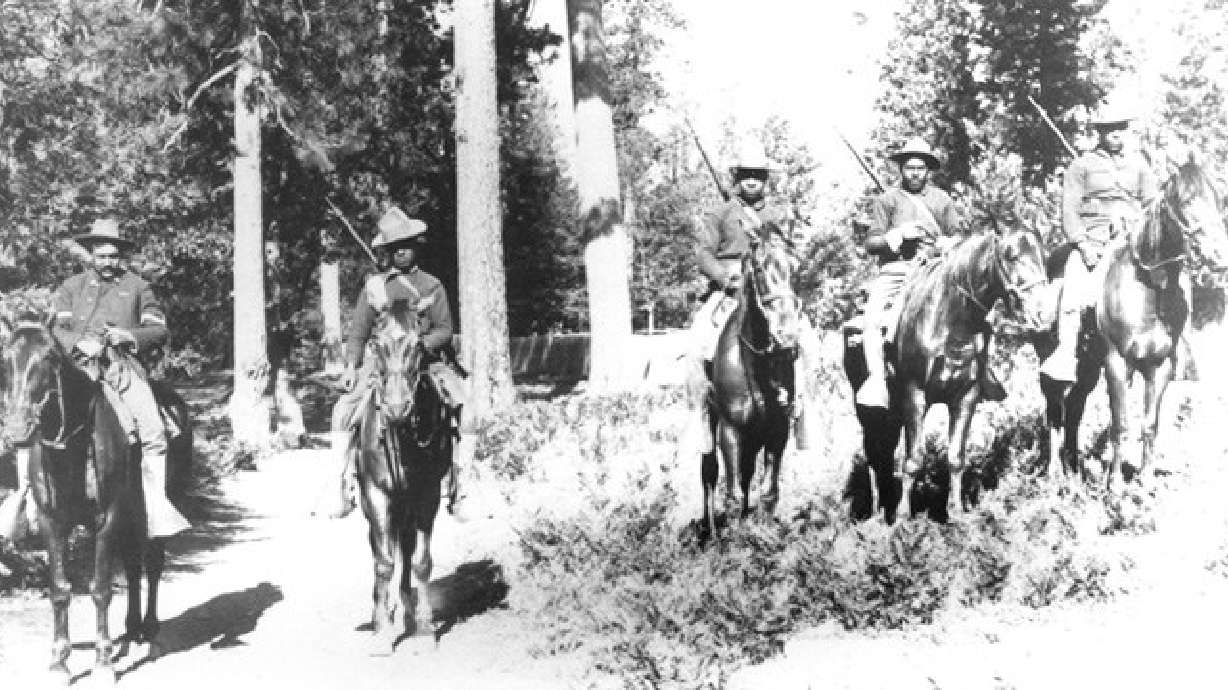Estimated read time: 4-5 minutes
This archived news story is available only for your personal, non-commercial use. Information in the story may be outdated or superseded by additional information. Reading or replaying the story in its archived form does not constitute a republication of the story.
Editor's note: This article is a part of a series reviewing Utah and U.S. history for KSL.com's Historic section.
SALT LAKE CITY — Among the earliest photos in Yellowstone National Park archives is an image of a little more than a half-dozen Black men standing next to bicycles at Minerva Terrace near Mammoth Hot Springs inside the park.
The men were a part of a group called the Fort Missoula Buffalo Soldier Bicycle Corps. Their job, according to park historians, wasn't easy at all. The group journeyed 1,900 miles from Missoula, Montana, to St. Louis in an effort to test how effective bicycles would be for the military.
There were also about 500 "buffalo soldiers" that became among the first individuals tasked with maintaining Yosemite and Sequoia national parks alone — another two of the earliest national parks. Essentially, they were park rangers before the National Park Service ever formed.
The concept of national parks isn't something that emerged at the creation of the U.S. in the 1700s or when the National Park Service was created in 1916. Congress designated the first national park, Yellowstone, in 1872 in the middle of the post-Civil War Reconstruction Era.
It chose the land within the Montana and Wyoming territories to be "a public park or pleasuring-ground for the benefit and enjoyment of the people," the later-formed park service noted. It was controlled by the Department of Interior, which is still the parent government agency over all national parks.
About a dozen national parks were created in the decades leading up to the Park Service; however, the U.S. needed people who were able to tend and maintain the land.
As the National Park Service wrote, the country mostly turned to military members in the early years of national parks. The famed "buffalo soldiers" were a major contributor.
Military groups were racially segregated after the Civil War. There were six infantries of African American soldiers formed in 1866 that were sent out West.
The infantries ended up in U.S. wars with Native American tribes that played out throughout the remainder of the century. Native Americans would go on to dub the all-Black 9th and 10th Cavalry Regiments "buffalo soldiers" for an unknown reason, History.com noted. The nickname stuck throughout history.
It's worth noting that with a bill signed in 2010, the U.S. would go on to formally apologize for the wars and other "ill-conceived policies" that adversely affected native tribes.
But the buffalo soldiers weren't assigned to solely fight in U.S. wars with indigenous tribes out West. Black infantries were also tasked with protecting stagecoaches and railroad crews — as the transcontinental line effort was underway — and capturing cattle thieves, History.com added.
By the time the Congress began approving more and more national parks, many Black military members served as park rangers. The soldiers conducted tasks that are familiar to tasks current employees handle today, especially at national parks in California.
"Their tasks included blazing trails, constructing roads, creating maps, evicting grazing livestock, extinguishing fires, monitoring tourists, and keeping poachers and loggers at bay," the National Park Service wrote.
Then there's the fascinating story behind the image of the eight Black members of the Fort Missoula Buffalo Soldier Bicycle Corps at Yellowstone National Park.
St. Louis Public Radio wrote about the group in 2017. It was in honor of the 120th anniversary of the team arriving in the city in 1897 after the 1,900-mile journey. Angela da Silva, a historian and adjunct professor at Lindenwood University in Missouri told the outlet that the group faced grueling conditions on its ride.
The group tested out the use of bicycles in the military at the time. It dealt with a snowstorm in the Rockies and 110-degree heat across Nebraska during the summer of 1897, the outlet reported.
"Their journey was followed in every newspaper across the country. They went through five states and there was a newspaperman embedded with them," da Silva said.
Yellowstone National Park officials pointed out the group didn't just face grueling weather and challenging terrain, but also inadequate supplies and "egregious racism and discrimination" throughout the difficult but successful journey.
As park official added: "Despite these challenges, however, they earned a reputation for serving courageously and helped establish a precedent for park management and stewardship that continues to this day."










